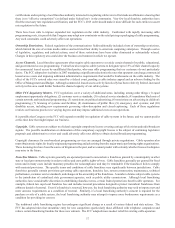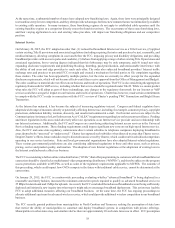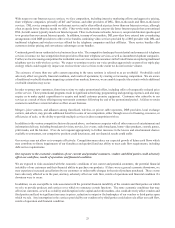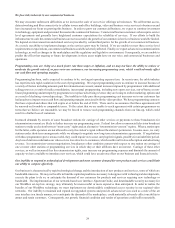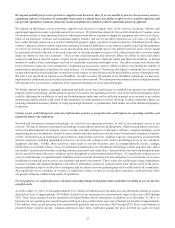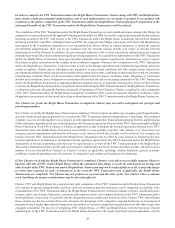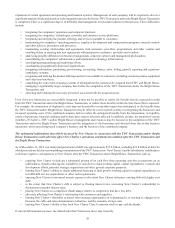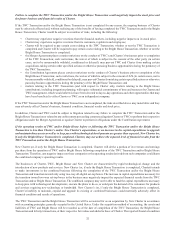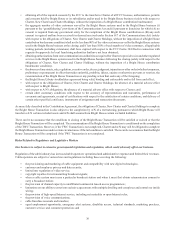Charter 2015 Annual Report Download - page 41
Download and view the complete annual report
Please find page 41 of the 2015 Charter annual report below. You can navigate through the pages in the report by either clicking on the pages listed below, or by using the keyword search tool below to find specific information within the annual report.26
accounting purposes, except for future taxable income that will result from the reversal of existing temporary differences for which
deferred tax liabilities are recognized. Such tax loss carryforwards can accumulate and be used to offset our future taxable income.
In the past, we have experienced “ownership changes” as defined in Section 382 of the Internal Revenue Code of 1986, as amended
(the “Code”). In general, an “ownership change” occurs whenever the percentage of the stock of a corporation owned, directly
or indirectly, by “5-percent stockholders” (within the meaning of Section 382 of the Code) increases by more than 50 percentage
points over the lowest percentage of the stock of such corporation owned, directly or indirectly, by such “5-percent stockholders”
at any time over the preceding three years. As a result, Charter is, and following the TWC transactions, New Charter (or, if only
the Bright House Transaction is completed, Charter) will be subject to an annual limitation on the use of our loss carryforwards
which existed at November 30, 2009 for the first “ownership change” and those that existed at May 1, 2013 for the second
“ownership change.” The limitation on our ability to use our loss carryforwards, in conjunction with the loss carryforward expiration
provisions, could reduce our ability to use a portion of our loss carryforwards to offset future taxable income, which could result
in us being required to make material cash tax payments. Our ability to make such income tax payments, if any, will depend at
such time on our liquidity or our ability to raise additional capital, and/or on receipt of payments or distributions from Charter
Holdco and its subsidiaries.
If we were to experience a third ownership change in the future (as a result of the transactions with TWC, Bright House and Liberty
Broadband or from purchases and sales of stock by our “5-percent stockholders,” new issuances or redemptions of our stock,
certain acquisitions of our stock and issuances, redemptions, sales or other dispositions or acquisitions of interests in our “5-percent
stockholders”), our ability to use our loss carryforwards could become subject to further limitations. Our common stock is subject
to certain transfer restrictions contained in our amended and restated certificate of incorporation. These restrictions, which are
designed to minimize the likelihood of an ownership change occurring and thereby preserve our ability to utilize our loss
carryforwards, are not currently operative but could become operative in the future if certain events occur and the restrictions are
imposed by our board of directors. However, there can be no assurance that our board of directors would choose to impose these
restrictions or that such restrictions, if imposed, would prevent an ownership change from occurring. These restrictions will be
eliminated if the Bright House Transaction is consummated.
If we are unable to retain key employees, our ability to manage our business could be adversely affected.
Our operational results have depended, and our future results will depend, upon the retention and continued performance of our
management team. Our ability to retain and hire new key employees for management positions could be impacted adversely by
the competitive environment for management talent in the broadband communications industry. The loss of the services of key
members of management and the inability or delay in hiring new key employees could adversely affect our ability to manage our
business and our future operational and financial results.
Our inability to successfully acquire and integrate other businesses, assets, products or technologies could harm our operating
results.
We continuously evaluate and pursue small and large acquisitions and strategic investments in businesses, products or technologies
that we believe could complement or expand our business or otherwise offer growth or cost-saving opportunities. From time to
time, we may enter into letters of intent with companies with which we are negotiating for potential acquisitions or investments,
or as to which we are conducting due diligence. An investment in, or acquisition of, complementary businesses, products or
technologies in the future could materially decrease the amount of our available cash or require us to seek additional equity or
debt financing. We may not be successful in negotiating the terms of any potential acquisition, conducting thorough due diligence,
financing the acquisition or effectively integrating the acquired business, product or technology into our existing business and
operations. Our due diligence may fail to identify all of the problems, liabilities or other shortcomings or challenges of an acquired
business, product or technology, including issues related to intellectual property, product quality or product architecture, regulatory
compliance practices, revenue recognition or other accounting practices, or employee or customer issues.
Additionally, in connection with any acquisitions we complete, we may not achieve the growth, synergies or other benefits we
expected to achieve, and we may incur write-downs, impairment charges or unforeseen liabilities that could negatively affect our
operating results or financial position or could otherwise harm our business. Further, contemplating or completing an acquisition
and integrating an acquired business, product or technology, individually or across multiple opportunities, could divert management
and employee time and resources from other matters. See “— Risks Related to the TWC Transaction and Bright House Transaction”
for risks specifically related to our proposed acquisitions of TWC and Bright House.



